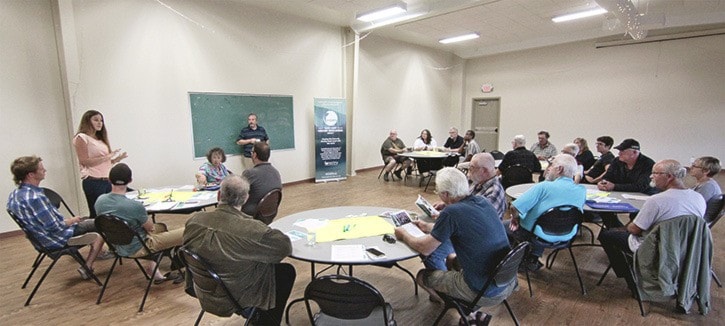Waves and surf were rolling in just across Beach Road last Thursday when Sandspit residents met to talk about hosting a university program on marine planning.
Run by the Haida Gwaii Higher Education Society, the idea is to bring 20 university students and several instructors to Sandspit for a four-month semester that involves local speakers, Haida Gwaii case studies, and field trips to Gwaii Haanas.
“This is just the first step,” said Dr. Carlos Ormond, the society’s executive director.
“Everything is still early.”
Since 2010, more than 200 university students have done a semester on Haida Gwaii, choosing one of two natural resource programs run at the Kay Centre in Skidegate.
Plans are already underway to start a new reconciliation studies semester in Old Massett and Masset in the fall of 2017.
If it goes ahead, Sandspit’s marine planning program would follow a year later at the earliest.
“This will be an all-islands institution,” said Tracy Morton, a Queen Charlotte physician and long-time board member of the non-profit HGHES.
Morton cautioned that each semester has to succeed on its own, and it’s too early yet for firm timelines on the Sandspit program.
But so far, Morton said the existing semesters are proving popular with students and instructors, and have helped to revitalize the islands by bringing in fresh faces and some $500,000 in economic activity each year.
Over a dozen Sandspit residents came out to the Thursday meeting, which was the first public talk about the marine planning semester.
It was called together by the HGHES and by the Sandspit Community Society.
“I think this can be a way to start building Sandspit back up,” said Heron Weir, one of the SCS directors.
“As a community society, that’s what our goal is.”
The Sandspit Community Society secured a GwaiiTrust grant to host the next step in the planning—a three-day meeting in Sandspit this November between experts from four B.C. universities and representatives of the HGHES, Gwaii Haanas, the Council of the Haida Nation, the Haida Oceans Technical Team, Fisheries and Oceans, and B.C.’s natural resources ministry.
Down the road, Weir said he hopes the society can help house, move, and feed students and instructors involved in the new program.
Along with the Sandspit Inn, the society runs shuttle buses between Sandspit and places like Morseby Camp.
“Our part is really going to be in the logistics,” said Weir.
Most residents who spoke at the meeting said they welcome the idea, but a few were skeptical about its prospects.
Bill Beldessi, a long-time resident and Sandspit’s representative on the regional district, said if he were an investor and the HGHES were selling shares, he wouldn’t buy right now.
Others questioned why students would pay extra costs to study on Haida Gwaii.
Noting that over 200 students have come for the existing HGHES semesters, Warren Foster said some students are keen to study outside a typical campus, and they might one day make better hires for employers here.
“There’s more to it than just their paper qualifications,” said Foster.
“They understand what life on the islands is about, because they’ve spent four or eight months here.”
Doug Gould questioned why the HGHES chose marine planning, which he described as a program that fosters bureaucrats.
“I would like jobs that aren’t about people spending our tax dollars,” he said, suggesting the HGHES chose something more vocational.
Ormond said the HGHES does not offer vocational programs partly because Northwest Community College already does, and has a marine biology program for first- and second-year students.
Also, given Haida Gwaii’s small population, Ormond said it would be impossible to run such programs year after year here without bringing in visiting students, which a place-based university program is able to do.
Ormond said there may well be challenges, but the HGHES has been hoping to expand to Sandspit for years, something he’s particularly excited about given his previous work with a similar marine ecology program in Panama.
“This is an ideal scenario, and there may be some bumps on the way,” he said of the current plan.
“If it were easy, everyone would be doing it.”
